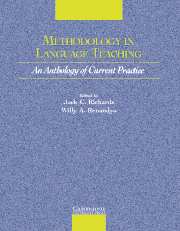Book contents
- Frontmatter
- Contents
- Acknowledgments
- Introduction
- Section I Approaches to Teaching
- Section 2 Lesson Planning and Classroom Management
- Section 3 Classroom Dynamics
- Section 4 Syllabus Design and Instructional Materials
- Section 5 Task and Project Work
- Section 6 Learning Strategies
- Section 7 Teaching Grammar
- Section 8 Teaching Pronunciation
- Section 9 Teaching Speaking
- Section 10 Teaching Listening
- Section 11 Teaching Vocabulary
- Section 12 Teaching Reading
- Section 13 Teaching Writing
- Section 14 Assessment
- Section 15 Technologies in the Classroom
- Section 16 Professional Development
- Credits
- Author Index
- Subject Index
Section 9 - Teaching Speaking
Published online by Cambridge University Press: 10 November 2010
- Frontmatter
- Contents
- Acknowledgments
- Introduction
- Section I Approaches to Teaching
- Section 2 Lesson Planning and Classroom Management
- Section 3 Classroom Dynamics
- Section 4 Syllabus Design and Instructional Materials
- Section 5 Task and Project Work
- Section 6 Learning Strategies
- Section 7 Teaching Grammar
- Section 8 Teaching Pronunciation
- Section 9 Teaching Speaking
- Section 10 Teaching Listening
- Section 11 Teaching Vocabulary
- Section 12 Teaching Reading
- Section 13 Teaching Writing
- Section 14 Assessment
- Section 15 Technologies in the Classroom
- Section 16 Professional Development
- Credits
- Author Index
- Subject Index
Summary
INTRODUCTION
A large percentage of the world's language learners study English in order to develop proficiency in speaking. The ability to speak a second or foreign language well is a very complex task if we try to understand the nature of what appears to be involved. To begin with, speaking is used for many different purposes, and each purpose involves different skills. When we use casual conversation, for example, our purposes may be to make social contact with people, to establish rapport, or to engage in the harmless chitchat that occupies much of the time we spend with friends. When we engage in discussion with someone, on the other hand, the purpose may be to seek or express opinions, to persuade someone about something, or to clarify information. In some situations, we use speaking to give instructions or to get things done. We may use speaking to describe things, to complain about people's behavior, to make polite requests, or to entertain people with jokes and anecdotes. Each of these different purposes for speaking implies knowledge of the rules that account for how spoken language reflects the context or situation in which speech occurs, the participants involved and their specific roles and relationships, and the kind of activity the speakers are involved in. In the last 20 or so years, linguists have provided a great deal of information on how speakers use language appropriately in different situations and clarified the complex nature of what is involved in developing spoken fluency in a second or foreign language.
- Type
- Chapter
- Information
- Methodology in Language TeachingAn Anthology of Current Practice, pp. 201 - 203Publisher: Cambridge University PressPrint publication year: 2002

